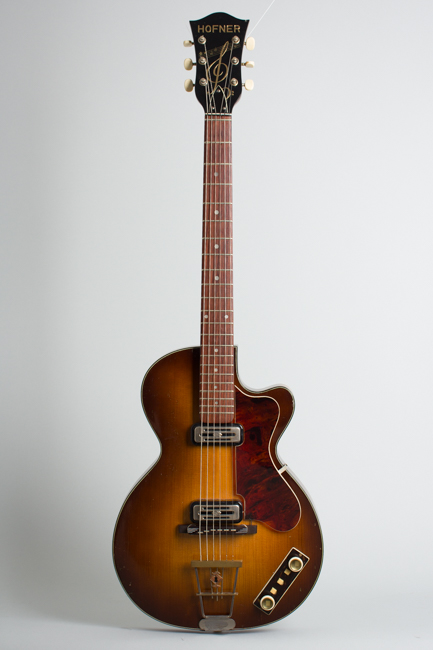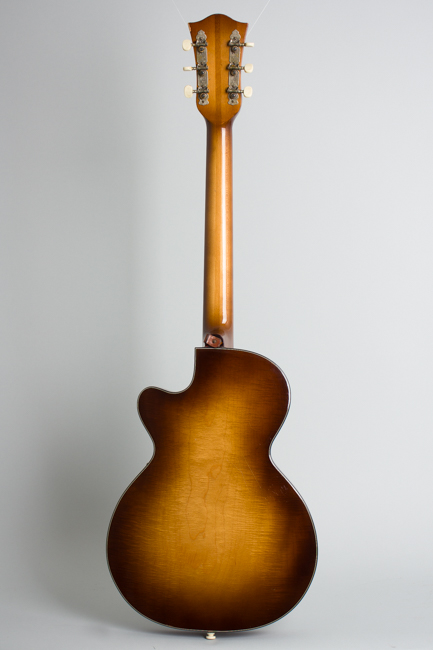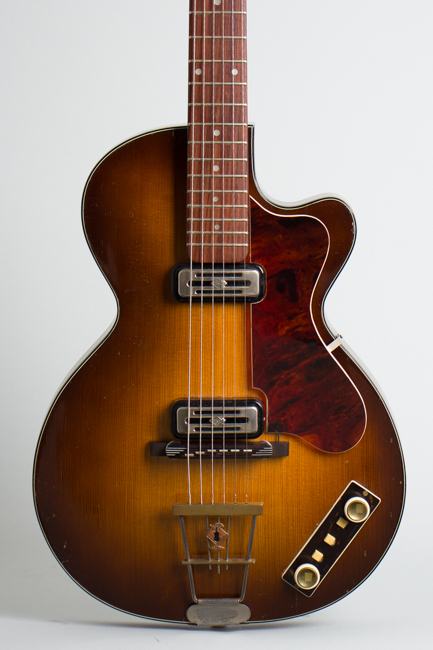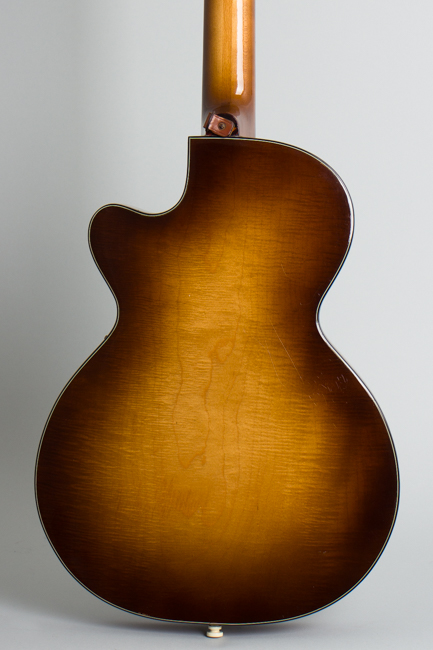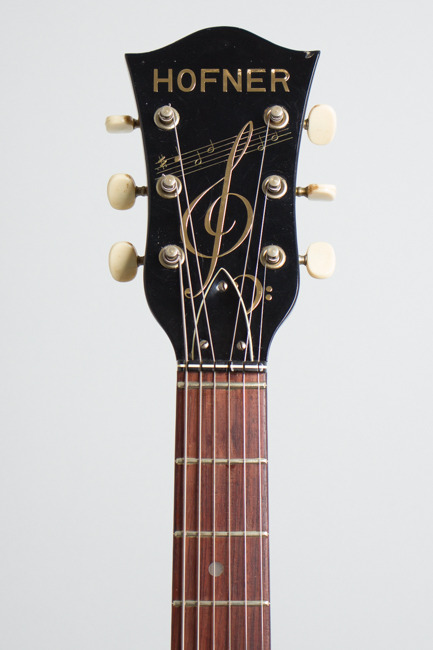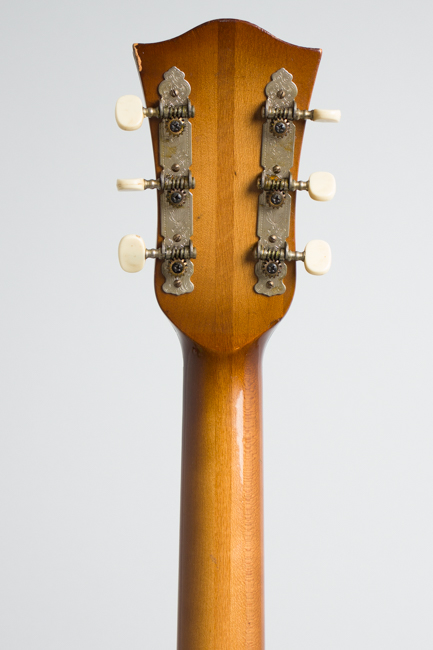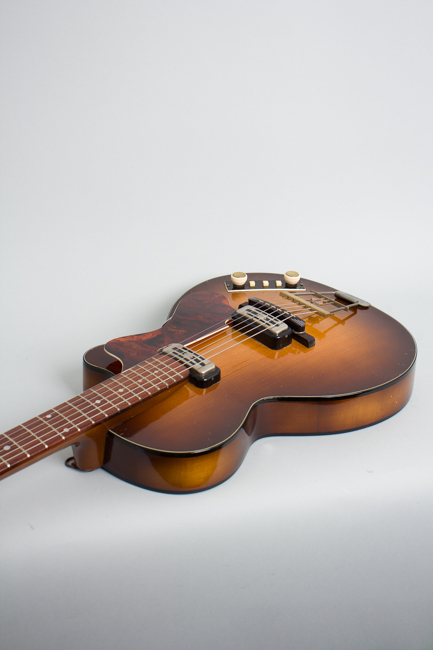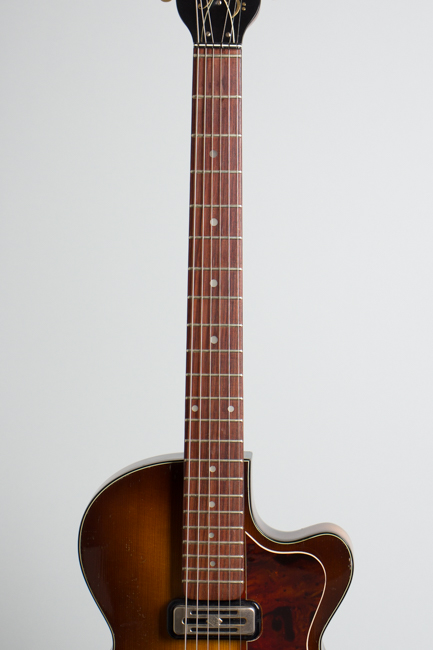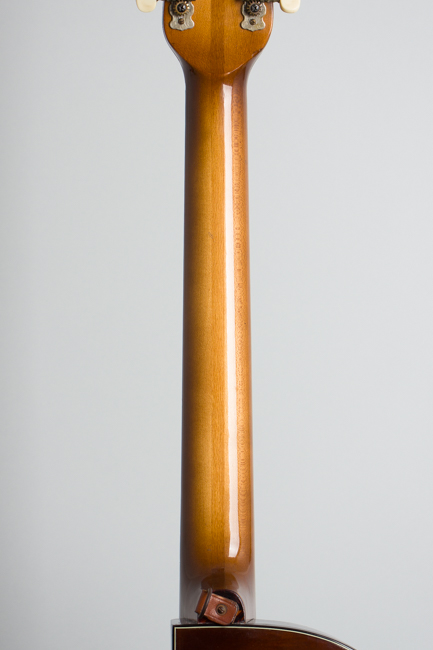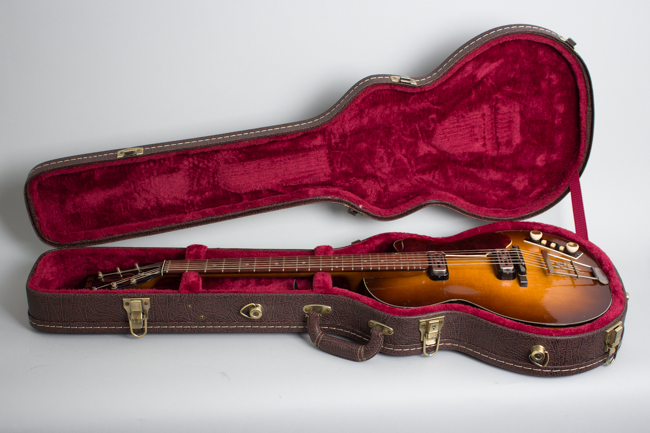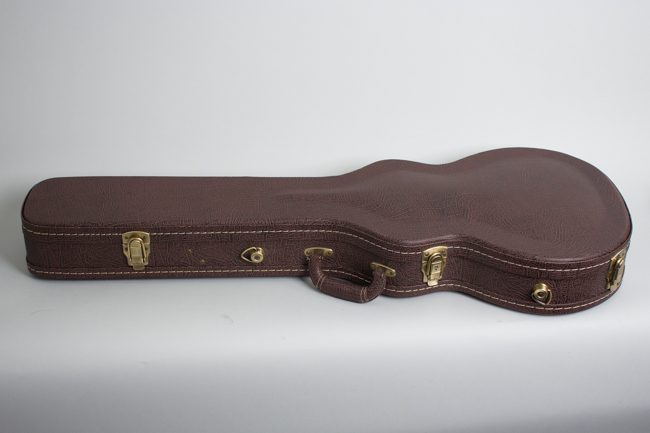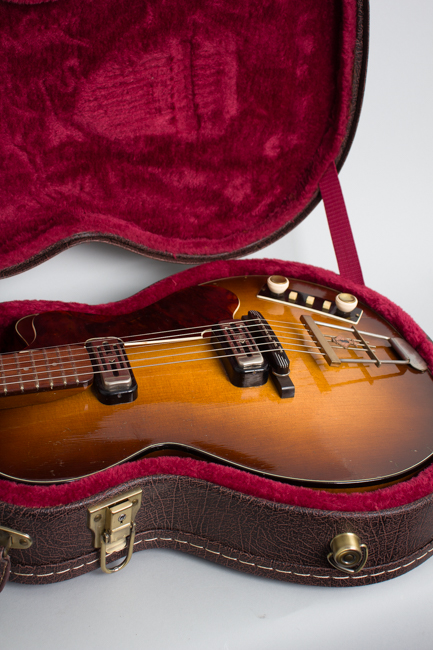Hofner Club 50 Arch Top Hollow Body Electric Guitar (1960)
Hofner Club 50 Model Arch Top Hollow Body Electric Guitar (1960), made in Bubenreuth, Germany, serial # 2668, sunburst lacquer finish, laminated maple body, spruce top; laminated maple neck with rosewood fingerboard, hard shell case.
The Club 50 is simply a classic beat Group guitar, a mainstay of the Liverpool and London music scenes in the late 1950s and early '60s. This two pickup, small hollow body electric was the generally preferred version of one of the German Hofner company's more original creations, the Club series electrics. This line of small-body slimline arch-tops with no sound holes were quite popular in Europe and especially the UK in the late '50s and early '60s. The Club 50 debuted in 1955 and this 1960-era "Brunette" model is the quintessential "Cavern Club" version
This particular Club 50 has a serial number stamped on the top edge of the headstock indicating the German-made instrument was originally handled by importer Von Wouw in Holland; it dates to late 1960. The guitar is basically identical to those sold by Selmer in London at the same time. Before American guitars were widely available the Club 50 was one of the best guitars available to the UK (and European) market, and was popular there but completely unknown in the Us at the time.
This example has features specific to 1960; the new metal-covered "Toaster" pickups are mated to the classic Hofner 2-knob, 3-switch "Flick Action" control panel introduced in 1958, with a tortoise celluloid plate. The body is made of laminated maple with a spruce top, the neck is a 3-piece maple laminate with an unbound rosewood fingerboard. The neck is fitted with a Gibson-style adjustable truss rod, a new feature at the time. The guitar has a nicely ambered dark sunburst finish overall, with triple dark binding on the body and a tortoise celluloid pickguard.
The Club models were among the most popular Beat-group guitars in early 1960s Liverpool and Hamburg; all three Beatle guitarists played the single-pickup Club 40 model during their early stages as a group. John McNally of the Searchers played a top-line Club 60 on all the group's early recordings, which remain an excellent demonstration of this guitar's capacity as a propulsive rhythm machine.
This original 1950s Club 50 is a very rare guitar in the US; they were not imported or sold here when new. Over the years some examples have been mostly brought over individually by Beat fans from Europe. The Club 50 may have been the most common of the series, but even so many of these beautifully made but rather fragile guitars have been lost to time and tide. This is a really nice clean example of this super cool Hofner classic in beautifully preserved, excellent playing condition.
Overall length is 38 in. (96.5 cm.), 13 in. (33 cm.) wide at lower bout, and 2 in. (5.1 cm.) in depth, measured at side of rim. Scale length is 24 1/4 in. (616 mm.). Width of nut is 1 5/8 in. (41 mm.).
This is a very nicely preserved and super playable example of this beat-group classic. The neck has recently been reset (ubiquitous on these) very cleanly with no damage or mess at the heel. The neck heel itself is completely solid with no separations, which is a common problem on old Hofners. The nicely aged finish shows checking overall (most notably on the top) and a collection of mostly minor dings, dents, and scrapes.
Everything on the instrument appears original except for a large strap pin added at the tail and a small leather dog-clip attachment on the neck heel, a neat period touch as these did not come with strap buttons originally. The tailpiece crossbars are unplated brass, it is likely the original plating was polished off but the effect is an attractive two-tone. The cool little "KH" (Karl Hofner) badge is intact on the tailpiece. The quirky "Flick Action" control is also fully intact and everything works as intended.
The fairly slim U-profile neck is nice and straight and the original frets show some old wear and re-crowning but still play well. This veteran beat era guitar sounds and plays great; close your eyes and play an E7 and you can be transported back to Liverpool or Hamburg in 1960, ready to "Mak Schau". It rests happily in a later (1970s) HSC, much sturdier than the pasteboard Hofner original. Overall Excellent - Condition.
The Club 50 is simply a classic beat Group guitar, a mainstay of the Liverpool and London music scenes in the late 1950s and early '60s. This two pickup, small hollow body electric was the generally preferred version of one of the German Hofner company's more original creations, the Club series electrics. This line of small-body slimline arch-tops with no sound holes were quite popular in Europe and especially the UK in the late '50s and early '60s. The Club 50 debuted in 1955 and this 1960-era "Brunette" model is the quintessential "Cavern Club" version
This particular Club 50 has a serial number stamped on the top edge of the headstock indicating the German-made instrument was originally handled by importer Von Wouw in Holland; it dates to late 1960. The guitar is basically identical to those sold by Selmer in London at the same time. Before American guitars were widely available the Club 50 was one of the best guitars available to the UK (and European) market, and was popular there but completely unknown in the Us at the time.
This example has features specific to 1960; the new metal-covered "Toaster" pickups are mated to the classic Hofner 2-knob, 3-switch "Flick Action" control panel introduced in 1958, with a tortoise celluloid plate. The body is made of laminated maple with a spruce top, the neck is a 3-piece maple laminate with an unbound rosewood fingerboard. The neck is fitted with a Gibson-style adjustable truss rod, a new feature at the time. The guitar has a nicely ambered dark sunburst finish overall, with triple dark binding on the body and a tortoise celluloid pickguard.
The Club models were among the most popular Beat-group guitars in early 1960s Liverpool and Hamburg; all three Beatle guitarists played the single-pickup Club 40 model during their early stages as a group. John McNally of the Searchers played a top-line Club 60 on all the group's early recordings, which remain an excellent demonstration of this guitar's capacity as a propulsive rhythm machine.
This original 1950s Club 50 is a very rare guitar in the US; they were not imported or sold here when new. Over the years some examples have been mostly brought over individually by Beat fans from Europe. The Club 50 may have been the most common of the series, but even so many of these beautifully made but rather fragile guitars have been lost to time and tide. This is a really nice clean example of this super cool Hofner classic in beautifully preserved, excellent playing condition.
Overall length is 38 in. (96.5 cm.), 13 in. (33 cm.) wide at lower bout, and 2 in. (5.1 cm.) in depth, measured at side of rim. Scale length is 24 1/4 in. (616 mm.). Width of nut is 1 5/8 in. (41 mm.).
This is a very nicely preserved and super playable example of this beat-group classic. The neck has recently been reset (ubiquitous on these) very cleanly with no damage or mess at the heel. The neck heel itself is completely solid with no separations, which is a common problem on old Hofners. The nicely aged finish shows checking overall (most notably on the top) and a collection of mostly minor dings, dents, and scrapes.
Everything on the instrument appears original except for a large strap pin added at the tail and a small leather dog-clip attachment on the neck heel, a neat period touch as these did not come with strap buttons originally. The tailpiece crossbars are unplated brass, it is likely the original plating was polished off but the effect is an attractive two-tone. The cool little "KH" (Karl Hofner) badge is intact on the tailpiece. The quirky "Flick Action" control is also fully intact and everything works as intended.
The fairly slim U-profile neck is nice and straight and the original frets show some old wear and re-crowning but still play well. This veteran beat era guitar sounds and plays great; close your eyes and play an E7 and you can be transported back to Liverpool or Hamburg in 1960, ready to "Mak Schau". It rests happily in a later (1970s) HSC, much sturdier than the pasteboard Hofner original. Overall Excellent - Condition.
